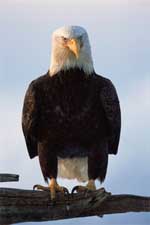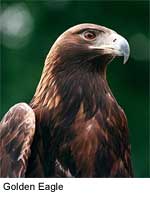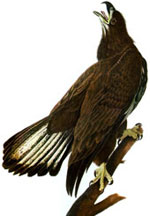
Eagle in General: Like all birds of prey, eagles have very large powerful hooked beaks for tearing flesh from their prey, strong legs and powerful talons. They also have extremely keen eyesight to enable them to spot potential prey from a very long distance. This keen eyesight is primarily contributed by their extremely large pupils which cause minimal diffraction (spreading) of the incoming light.
-----------------------------------------------------------------------------------------------------------------------------
Bald Eagle
 Just the Facts: The Bald Eagle, also known as the American Eagle, is a bird of prey found in North America, most recognizable as the national bird of the United States. The species was on the brink of extinction in the USA late in the 20th century but now has a stable population and is in the process of being removed from the U.S. federal government's list of endangered species. Just the Facts: The Bald Eagle, also known as the American Eagle, is a bird of prey found in North America, most recognizable as the national bird of the United States. The species was on the brink of extinction in the USA late in the 20th century but now has a stable population and is in the process of being removed from the U.S. federal government's list of endangered species.
Bald Eagle name: The bird gets both its common and scientific names from the appearance of the adult's head. The English name (Bald) refers to the white head feathers, and the scientific name is derived from Haliaeetus, the New Latin for "sea eagle," (from the Greek haliaetos) and leucocephalus, Greek for "white head," from leukos ("white") and kephale ("head").
Bald Eagle's natural range: The Bald Eagle's natural range includes most of North America, including most of Canada, all of the continental United States, and northern Mexico. The bird itself is able to live in most of North America's varied habitat from the bayous of Louisiana to the Sonoran desert to the eastern deciduous forests of Quebec and New England. It can be a migratory bird but it also is not unheard of for a nesting pair to overwinter in a particular area.
Bald Eagle Endangerment: Once a common sight in much of the continent, the Bald Eagle was severely affected by the widespread use of DDT in the mid-twentieth century. While the pesticide itself was not lethal to the bird, its exposure would either make an eagle sterile or inhibit its ability to lay healthy eggs: the eagle would ingest the chemical through its food and then lay eggs that were too brittle to withstand the weight of a brooding adult. By the 1960's there were fewer than 500 nesting pairs in the 48 contiguous states of the USA.
Bald Eagle recovery: Currently the Bald Eagle is slowly but steadily recovering its numbers; it can be found in growing concentrations throughout the United States. and Canada, particularly near large bodies of water. The U.S. state with the largest resident population is Alaska; out of the estimated 100,000 Bald Eagles on Earth, half live there.
The only Bald Eagle to be hatched outside North America was born on May 3, 2006 in a zoo in the German city of Magdeburg.
----------------------------------------------------------------------------------------------------------------------------
Golden Eagle
 Distribution: At one time, the Golden Eagle lived in temperate Europe, North Asia, North America, North Africa and Japan. In most areas this bird is now a mountain-dweller, but in former centuries it also bred in the plains and the forests. In recent years it has started to breed in lowland areas again (Sweden, Denmark). Distribution: At one time, the Golden Eagle lived in temperate Europe, North Asia, North America, North Africa and Japan. In most areas this bird is now a mountain-dweller, but in former centuries it also bred in the plains and the forests. In recent years it has started to breed in lowland areas again (Sweden, Denmark).
There was a great decline in Central Europe, and the Golden Eagle is now restricted to the higher central Appennine regions of Italy (Regional capital of Abruzzo is named after the latin/Italian word for eagle, L'Aquila) source, and the Alps.
In Britain, there are about 420 pairs left in the Scottish highlands, and between 1969 and 2004 they bred in the English Lake District. In North America the situation is not as dramatic, but there has still been a noticeable decline.
Falconry: In Central Asia, Golden Eagles sometimes are trained for falconry, and in Kazakhstan there are still hunters using these eagles in order to catch deer and antelopes.
Mating: A pair of Golden Eagles remains together for life. They build several nests within their territory and use them alternately for several years. The nest consists of heavy tree branches, upholstered with grass.
 Nests: Old nests may be 2 metres (6.6 ft) in diameter and 1 metre (3.3 ft) in height, as the eagles enlarge their nests every year. If the eyrie is situated on a tree, supporting tree branches may break because of the weight of the nest. Nests: Old nests may be 2 metres (6.6 ft) in diameter and 1 metre (3.3 ft) in height, as the eagles enlarge their nests every year. If the eyrie is situated on a tree, supporting tree branches may break because of the weight of the nest.
Eggs: The female lays two eggs between January
and May (depending on the area). After 45 days the
young hatch. They are entirely white and are fed
for fifty
days before they are able to make their first flight attempts and eat on their own. In most cases only
the older chick, which takes most of the
food, survives, while the younger one dies before leaving the eyrie.
All text is available under the terms
of the GNU Free Documentation License |